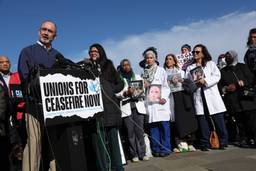President Obama finally put immigration reform on his agenda this month, inviting dozens of advocates to the White House and reaffirming his “unwavering” commitment to change. Coincidentally or not, it’s also the month that thousands have marched on Washington to remind the president of his vows. But the question isn’t just when the administration and Democrats will focus on immigration; it’s what they’ll achieve. If the past 15 months are a guide, the answer is not much.
The number of people deported by Immigration and Customs Enforcement (ICE) actually increased in Obama’s first year in office, reaching close to 388,000, more than ever before in history. That’s an average of more than 1,000 deportations a day and is more than double the annual number for 2001 – when Bush entered the White House, 9/11 rocked the country and deportations began climbing.
The Bush administration’s immigration policy purported to target dangerous criminals and terrorists in the name of public safety and national security. To achieve that, Bush’s national security appointees built out the enforcement structure, particularly with an eye toward strengthening the role of local police. They built the Criminal Alien Program to nab immigrants when they’re booked into local jails and expanded the “287g” program, which deputizes cops to enforce immigration law.
But as this new structure settled in, it took on a life of its own. As an Obama administration report revealed last fall, by 2009 well over half of the people ICE detained and deported were scooped up through these new programs that were supposed to focus on catching dangerous criminals. Yet, the majority had no criminal records at all. And the bulk of detainees who did have criminal records had served out their jail time decades earlier, and largely for non-violent crimes. Rather than focusing enforcement around criminals and terrorists, Bush’s programs had just built a massive deportation pipeline. If the trend line Bush’s enforcement structure set in motion continues, we’re on pace to be deporting around half a million people a year by 2013.
Now, the Obama administration’s reform goal is to achieve what Bush only purported to do: Focus enforcement on dangerous criminals and terrorists. “As an investigative agency, ICE prioritizes our immigration enforcement efforts to target those who threaten the security of the American people,” says Obama’s ICE chief, John Morton. The political tradeoff seems clear: A tough-enforcement perspective can give Democrats the space to create paths to citizenship.
Lurking behind this set up, however, is a framework that has always shaped immigration politics and policy in Washington. We cling to two ideas of who immigrants are. There are good immigrants and there are bad ones. The good ones are the workers; the bad ones are the criminals. From Bush to Obama, Washington’s policy choices have been rooted in this notion.
If only life were so simple. The problem is that tough “enforcement” has never really been about deporting dangerous criminals or securing the border against terrorists. It’s really meant tearing apart thousands of families a year as a result of minor and often decades-old interactions with the cops.
Even before Bush built his deportation pipeline, it wasn’t hard to fall on the wrong side of enforcement, regardless of your immigration status. As a result of laws passed in back 1996, just about any conviction, even for things as minor as pot possession, results in mandatory deportation. No mitigating circumstances, no trial, no appeal, just deportation. In many cases, judges have lost discretion to consider things like family ties or the nature of a crime.
Obama is expanding this enforcement structure. At the administration’s request, Congress approved an additional $71 million for new detention beds last year and appropriated $150 million to facilitate cops’ efforts in checking the immigration status of anyone they book into their facilities. He’s also maintained and expanded the 287g program. These are the very programs that authorized the likes of Sherriff Joe Arpaio to set up sweltering tent cities to house thousands of immigrants in the desert. Meanwhile, the administration has failed to investigate ICE cover-ups of deaths in detention and continues to deport people without a fair day in court.
As I reported in a recent ColorLines investigation, Torn Apart by Deportation, this out-of-control enforcement apparatus is plunging families into chaos. On a recent afternoon in Washington, D.C., I sat down with Yvonne Johnson, a middle-aged Jamaican-American woman whose schizophrenic son had recently been deported, for a crime he’d committed when he was a teenager. He has no known family in Jamaica – he’d come here when he was a little boy – and Johnson had not heard from him in a week. She fears he may have ended up homeless. That’s where she may be headed, too. After dumping thousands of dollars into a futile effort to stop her son’s deportation, Johnson is sliding into foreclosure.
Multiply this story by almost 100,000 – the number of people deported as a result of criminal convictions last year – and we’re talking about tearing communities to shreds. In the first quarter of 2010, the proportion of all ICE detainees who were there as a result of a criminal conviction rose to 43 percent, up from 27 percent in 2009, according to the non-partisan Transnational Records Access Clearinghouse. ICE has yet to release the total number of detainees for this period, and it’s possible that the dramatic proportional shift reflects a large drop in non-criminal deportations. But the trend likely foreshadows a future in which more and more immigrants, regardless of status, are detained and deported because of interactions with cops and courts.
Thus far, there’s no indication that the bipartisan reform bill Sens. Charles Schumer and Lindsey Graham have been drafting will alter this course. Schumer’s office didn’t return requests for information about what’s in the bill and negotiations have unfolded largely behind closed doors. But Brittney Nystrom, policy director of the National Immigration Forum, pointed to two existing bills as examples of true change: Rep. Luiz Gutierez’s Comprehensive Immigration Reform ASAP bill in the House and the Refugee Protection Act in the Senate.
”They present many of the elements of an immigration reform we’re pushing for,” said Nystrom, “such as dealing with conditions in detention, a path for legalization and language that would restore discretion to immigration judges” in making deportation decisions.
Ultimately, immigration reform cannot be addressed as a purely economic issue. It is also a moral question: Is a system that tears apart hundreds of thousands of families a year one that reflects American values? If President Obama believes it is not, then he must chart a very different course toward change.
This article was originally published by ColorLines.
SPECIAL DEAL: Subscribe to our award-winning print magazine, a publication Bernie Sanders calls "unapologetically on the side of social and economic justice," for just $1 an issue! That means you'll get 10 issues a year for $9.95.



